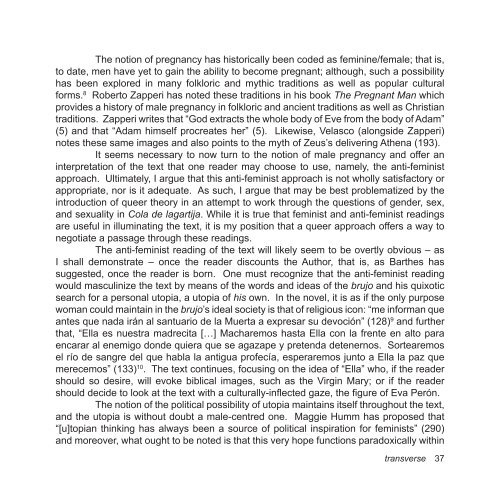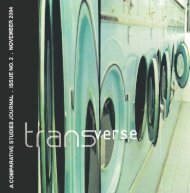Untitled - Centre for Comparative Literature - University of Toronto
Untitled - Centre for Comparative Literature - University of Toronto
Untitled - Centre for Comparative Literature - University of Toronto
You also want an ePaper? Increase the reach of your titles
YUMPU automatically turns print PDFs into web optimized ePapers that Google loves.
The notion <strong>of</strong> pregnancy has historically been coded as feminine/female; that is,<br />
to date, men have yet to gain the ability to become pregnant; although, such a possibility<br />
has been explored in many folkloric and mythic traditions as well as popular cultural<br />
<strong>for</strong>ms. 8 Roberto Zapperi has noted these traditions in his book The Pregnant Man which<br />
provides a history <strong>of</strong> male pregnancy in folkloric and ancient traditions as well as Christian<br />
traditions. Zapperi writes that “God extracts the whole body <strong>of</strong> Eve from the body <strong>of</strong> Adam”<br />
(5) and that “Adam himself procreates her” (5). Likewise, Velasco (alongside Zapperi)<br />
notes these same images and also points to the myth <strong>of</strong> Zeus’s delivering Athena (193).<br />
It seems necessary to now turn to the notion <strong>of</strong> male pregnancy and <strong>of</strong>fer an<br />
interpretation <strong>of</strong> the text that one reader may choose to use, namely, the anti-feminist<br />
approach. Ultimately, I argue that this anti-feminist approach is not wholly satisfactory or<br />
appropriate, nor is it adequate. As such, I argue that may be best problematized by the<br />
introduction <strong>of</strong> queer theory in an attempt to work through the questions <strong>of</strong> gender, sex,<br />
and sexuality in Cola de lagartija. While it is true that feminist and anti-feminist readings<br />
are useful in illuminating the text, it is my position that a queer approach <strong>of</strong>fers a way to<br />
negotiate a passage through these readings.<br />
The anti-feminist reading <strong>of</strong> the text will likely seem to be overtly obvious – as<br />
I shall demonstrate – once the reader discounts the Author, that is, as Barthes has<br />
suggested, once the reader is born. One must recognize that the anti-feminist reading<br />
would masculinize the text by means <strong>of</strong> the words and ideas <strong>of</strong> the brujo and his quixotic<br />
search <strong>for</strong> a personal utopia, a utopia <strong>of</strong> his own. In the novel, it is as if the only purpose<br />
woman could maintain in the brujo’s ideal society is that <strong>of</strong> religious icon: “me in<strong>for</strong>man que<br />
antes que nada irán al santuario de la Muerta a expresar su devoción” (128) 9 and further<br />
that, “Ella es nuestra madrecita […] Macharemos hasta Ella con la frente en alto para<br />
encarar al enemigo donde quiera que se agazape y pretenda detenernos. Sortearemos<br />
el río de sangre del que habla la antigua pr<strong>of</strong>ecía, esperaremos junto a Ella la paz que<br />
merecemos” (133) 10 . The text continues, focusing on the idea <strong>of</strong> “Ella” who, if the reader<br />
should so desire, will evoke biblical images, such as the Virgin Mary; or if the reader<br />
should decide to look at the text with a culturally-infl ected gaze, the fi gure <strong>of</strong> Eva Perón.<br />
The notion <strong>of</strong> the political possibility <strong>of</strong> utopia maintains itself throughout the text,<br />
and the utopia is without doubt a male-centred one. Maggie Humm has proposed that<br />
“[u]topian thinking has always been a source <strong>of</strong> political inspiration <strong>for</strong> feminists” (290)<br />
and moreover, what ought to be noted is that this very hope functions paradoxically within<br />
transverse 37




